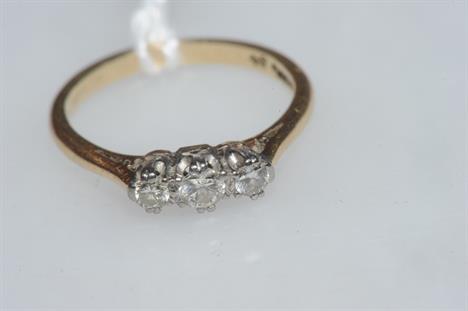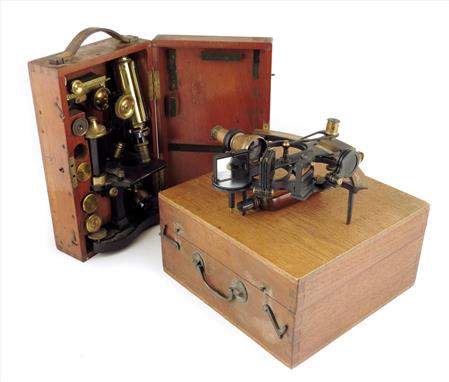We found 1087811 price guide item(s) matching your search
There are 1087811 lots that match your search criteria. Subscribe now to get instant access to the full price guide service.
Click here to subscribe- List
- Grid
-
1087811 item(s)/page
A BELL BELIEVED TO BE FROM THE S.S. GREAT EASTERN, un-named, cast in brass with moulded rim and shoulder, staple for clapper (missing) and suspension ring -- 10 x 12½in. (25.5 x 31.7cm.) on a wall-mounted oak frame with brass plaque engraved BELL OF THE GREAT EASTERN -- 54 x 12in. (137 x 30.5cm.); photocopy of cover and page from 1888 sales catalogue; letter confirming provenance, Provenance: Believed sold by Messrs Dixon & Moore of Liverpool at the Great Eastern dispersal sale of 20th-22nd November 1888 and purchased by James C. Farrie, great-grandfather of the vendor. In 1957 it was inherited by the vendor`s mother and, from 1977-2012, was on loan to the Great Britain Museum, Bristol. In 1888 James C. Farrie and his son James C. Farrie Jr. were cotton brokers living and working in Liverpool and are thought to have bought this bell as a souvenir. It is believed that the Great Eastern had two or even three bells and that this unmarked example was possibly located on one of the mid-ship masts. Her named maker`s bell was recently re-discovered and resides in the Liverpool Maritime Museum.
AN 18TH-CENTURY BRASS POCKET COMPASS SUNDIAL IN THE MANNER OF ANDREAS VOGLER, with 1in. dial with blued-steel needle, folding latitude arm, hinged chapter ring and gnomon, the reverse engraved with European town latitudes and erroneously signed AND VOGLER -- 2in. (5cm.) overall
A MID 20TH-CENTURY 7IN. STAR GLOBE BY KELVIN & HUGHES LTD, with paper gores applied to a wooden core, maker`s label inscribed Kelvin & Hughes Ltd Star Globe Epoch 1975 printed by George Philip & Son Ltd, set within brass meridian ring with removable star pointer frame, contained in mahogany box with instructions inside lid -- 11in. (28cm.) square
A LATE 19TH-CENTURY AMERICAN LIQUID-FILLED COMPASS BY RITCHIE, BOSTON, with 7½in. card signed Ritchie Boston USA, contained in liquid-filled bowl with rim stamped SS RITCHIE BOSTON and patent dates for 1862, 1866 and 1870, mounted in a substantial brass gimbal ring within oak travel box -- 7¼ x 13½ x 13½in. (18.5 x 34.3 x 34.3cm.)
λA silver repousse pair cased verge watch with tortoiseshell outer, signed J. Wilders, London, no. 310, square baluster pillars, continental bridge cock, enamel dial decorated with a shipping scene, outside the chapter ring, inner case plain, outer repousse with three figures amongst rococo scroll work, the triple outer shell covered with pique work, London 1785, 58mm diameter.
An oak 30 hour longcase clock, the 11 inch brass dial with rococo spandrels and silvered chapter ring, signed in the centre Rich. Gilkes, Devizes amongst engraved foliage and a bird, large calendar sector, four pillar movement in a plain case, flat hood with caddy top and blind fret, 77in (196cm) high.
A French empire ormolu and bronze mantel clock, the silk suspension movement with gilt dial and white enamel annular chapter ring in a case of urn form, surmounted by a figure of Venus seated in a sea shell pulled by a pair of doves, the base with applied figures of Neptune and putti riding hippocampi, now on a later marble base, 14in (36cm) high.
A mahogany longcase regulator, the 12 inch circular painted dial singed G. Blackie, London with concentric minutes, subsidiary dial for seconds and 24 hour chapter ring, the four pillar rectangular plated movement with dead beat escapement and maintaining power, the pendulum with cylindrical brass bob supported from the back board, the flame veneered case with flat hood, the glazed trunk door flanked by canted corners, 75in (190cm) high.
A walnut eight day longcase clock, the 10 inch brass dial signed John Martin, Londini Fecit beneath the silvered chapter ring, the matted centre with slender subsdidary seconds and date aperture, mask and scroll spandrels, the movement with five latched ringed pillars, bolt and shutter maintaining power, locking plate striking, the case with spoon and rising hood, blind fret flanked by barley twist columns, the slender trunk door with geometric boxwood stringing, crossbanded sides, on bun feet, 76in (193cm) high.
Christopher Gould. An early 18th century month duration burr walnut longcase clock, the 12 inch brass dial signed below the silvered chapter ring Chr. Gould, Londini Fecit, the matted centre with subsidiary seconds and date aperture, ringed winding holes and engraved rosette to centre, mask and scroll spandrels divided by engraved foliage, the six ringed pillar movement with locking plate striking and anchor escapement, in a case of warm colour, the flat hood with caddy top and frets, finial blocks to the sides (finials lacking), the sides and plinth with herringbone inlays and crossbanded panels, 88in (223cm) high. Christopher Gould. Free of the Clockmakers Company 1682. Died 1718. A maker of great repute, especially of longcase clocks.
*A good George III red japanned tavern timepiece, signed Rich. Lawrence, Bath, circular black painted dial with gilt Roman hours and outer Arabic minute ring, pierced spade hands with counterbalanced minute, movement with anchor escapement in tapered plates, the trunk door decorated with Chinese figures by a lake with pagoda in the background, signed between the florally carved and scrolled gilt ears, the whole decorated with gilt floral designs against a dark red ground, 59in (150cm) high, bezel 29in (74cm) diameter.
A universal equinotcal dial, Augsburg, the reverse signed Ioh. G. Vogler beneath a list of cities and latitudes, the octagonal brass plate engraved with hunting scenes, hinged hour ring and gnomon and adjustable latitude arc, inset silvered compass, 3in (7.5cm) wide, in leather ad card travelling case.
Libri Antichi e Rari Lutero, Martino. Das Elltern die Kinder zur Ehe nicht zwingen noch hyndern und die Kinder on der elltern willen sich nicht verloben sollen [Wittenberg, Lukas Cranach e Christian Döring, 1524]. In 4° (191 x 145 mm); [6] carte. Titolo entro bella xilografia architettonica a cura di Lukas Cranach il Vecchio (1472-1553) con la rossetta di Lutero, tenuta da due angioletti, in calce. Legatura posteriore in piena pergamena floscia. Prima edizione dell’opera dedicata a Hans Schott, il quale Lutero conobbe durante il soggiorno a Worms nel 1518. Alla base della cornice architettonica del frontespizio è stampato il versetto “Er schuff sie eyn menlin und frewlin” (“Egli li creò maschio e femmina”, Matt. 19,4), che Lutero commenta in questa sua lettera. VD 16 L-4301; Benzing 1906. Starting Price: €700
-
1087811 item(s)/page























































-2013102610445_468x382.jpg)


